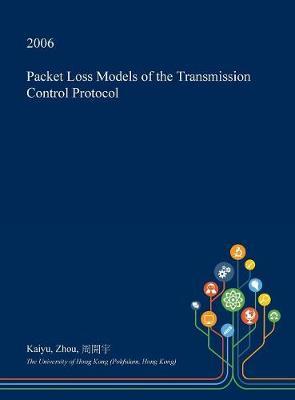Overview
This dissertation, Packet Loss Models of the Transmission Control Protocol by Kaiyu, Zhou, 周開宇, was obtained from The University of Hong Kong (Pokfulam, Hong Kong) and is being sold pursuant to Creative Commons: Attribution 3.0 Hong Kong License. The content of this dissertation has not been altered in any way. We have altered the formatting in order to facilitate the ease of printing and reading of the dissertation. All rights not granted by the above license are retained by the author. Abstract: ABSTRACT Despite the considerable research efforts on building analytical models to evaluate and improve our understanding on Transmission Control Protocol (TCP) dynamics, we find that the previous studies have two main deficiencies. Firstly, none of the work gives sufficient treatment to TCP slow-start, although almost all of them have shown that retransmission timeouts are common. Secondly, the causes of retransmission timeout are not analyzed with sufficient details, although timeouts greatly degrade TCP performance. In this thesis, three widely adopted TCP implementations, Reno, New-reno, and Sack, are modelled under two popular packet loss models, the bursty loss model and the independent loss model. The bursty loss model is designed to capture the loss characteristics of Drop-Tail routers, whereas the independent loss model is for Active Queue Management (AQM) routers. To address the two deficiencies identified above, we propose an analytical framework that enables the study of all TCP congestion control mechanisms, namely, slow-start, congestion avoidance, fast retransmit, fast recovery, and retransmission timeout. The probability that a timeout occurs is then modelled by conditioning on the different timeout events following a loss. By analyzing the congestion window evolution, the TCP steady state throughput is derived. Based on the same analytical framework, we also study TCP performance in Optical Burst Switching (OBS) networks. Being a promising backbone technology for the future Internet, OBS networks are characterized by the assembly of multiple IP packets into a single burst, and the switching of bursts through a bufferless core. Due to the nature of one-way resource II reservation, bursts suffer from a relatively high loss probability (due to reservation failure). In addition to the study of different timeout events of TCP over OBS networks, the assembly/de-assembly mechanisms under the random burst loss model are analyzed in this thesis. In OBS networks, due to the loss of multiple IP packets in a single burst, TCP suffers the False Timeout (FTO) problem. To solve FTO, we propose a simple but effective mechanism, Interleaved Traffic Splitting (ITS). ITS requires only modifications to the assembly/de-assembly mechanisms implemented at edge OBS routers. At an ingress OBS router, packets from a TCP flow are split into multiple bursts, interleaving with packets from other flows. Through such a parallel assembly process, the number of packets from the same window of data and assembled into the same burst is reduced. We show that TCP throughput can be significantly improved with ITS. We also show that splitting and merging using two parallel bursts generally performs better than adopting more bursts. Although we show that the analytical models adopted by TCP Friendly Rate Control (TFRC) are problematic, its analytical results match quite well with experimental results. This contradiction motivates us to validate the usage of packet loss models. Our investigation confirms that adopting the independent packet loss model under AQM is generally accurate. But the use of the bursty loss model under Drop-Tail is problematic, because no evidence of high correlation between losses can be found with simulations. This shows that the accuracy of the TFRC models is due to error cancellation between their TCP model and the packet loss model. III DOI: 10.5353/th_b3687317 Subjects:
Full Product Details
Author: Kaiyu Zhou ,
周開宇
Publisher: Open Dissertation Press
Imprint: Open Dissertation Press
Dimensions:
Width: 21.60cm
, Height: 1.30cm
, Length: 27.90cm
Weight: 0.735kg
ISBN: 9781361469101
ISBN 10: 1361469102
Publication Date: 27 January 2017
Audience:
General/trade
,
General
Format: Hardback
Publisher's Status: Active
Availability: Temporarily unavailable

The supplier advises that this item is temporarily unavailable. It will be ordered for you and placed on backorder. Once it does come back in stock, we will ship it out to you.



